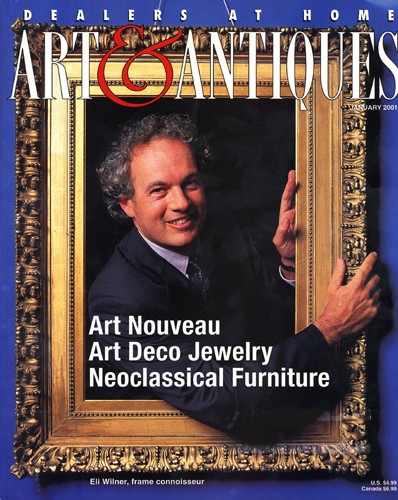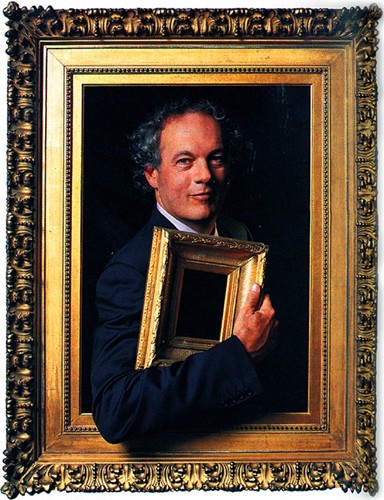Meet Mr Frame
Eli Wilner proves that there are bucks in those borders, too.
By Nancy A. Ruhling Photography by Simon Alexander
Art & Antiques Magazine
January 2001 Cover and Page 112
Just show Eli Wilner a painting, and he waxes poetic – not about the picture, but about its frame. “The frame is the soul of the painting,” he exclaims, running his finger gently over the gilded curves of a 19th-century Italian frame in his Manhattan gallery. “When the frame is perfect, it brings the painting out. It is a work of art. It is sculpture.” It is also quite valuable, thanks largely to Wilner. He has elevated the antique picture frame to an art form.
Wilner, a self-confessed frame-o-phile so enamored of the form that he has earned the affectionate title “Mr. Frame,” came into the picture (so to speak) in 1983 – a time when museums and galleries, in a quest to “modernize” their collections, were more likely to discard than display period frames. Their trash literally turned into Wilner’s treasure: He rode up and down Madison Avenue rescuing prime examples designed by 19th- and 20th-century greats like Louis Comfort Tiffany, Stanford White and James McNeill Whistler. Then he began to scour every attic and antiques shop in the state, snapping up frames for about $25 each. Before he knew it, he had invested $6,000 in hundreds of these “dusty old Frames,” which he crammed into his studio apartment.
Wilner woke up to his destiny as a frame dealer – literally – after one of them fell off the wall and knocked him on the head while he was sleeping. He started doing avant-garde things with the frames, such as hanging them on the walls empty, with one inside the other, and selling them as sculpture. He put mirrors in them and turned them into display trays, coffee tables and room dividers. Occasionally, he even put paintings in them.
“When I started in 1983, the highest price for my best frame was $1,500,” he says. “Last year, I sold a frame of comparable quality for $185,000. Even I never dreamed that they would go beyond $5,000-10,000. Now I believe there will be frames that go for half a million. Not now, perhaps, but maybe 10 years from now.”
It was Wilner who persuaded major museums and institutions, including the White House, to allow him to reproduce, restore and conserve frames for them, and it was Wilner who sponsored the world’s first frames-only exhibition, which was held at the Metropolitan Museum of Art in 1990.
“Eli has been invaluable to my study of period frames and to my inventory and analysis of the Met’s collection,” says Carrie Rebora Barratt, associate curator of American paintings and sculpture. “I know he has been helpful to other curators with his time and expertise.” With the arrival of the 21st century Wilner’s time frame has shifted somewhat. “The best frames still are the 19th- and early 20th-century masterpieces, but now frames from the ’50s and ’60s are in great demand because paintings from the 1950s and 1960s are being collected,” he says.
Now that he’s gotten some of the art world to recognize frames for frames’ sake, the 44-year-old Wilner has no intention of resting on his laurels – gilt, carved or otherwise. He’s letting his frames speak through The Gilded Edge: The Art of the Frame, the book he edited that has just been published by Chronicle Books, and through the newly released second edition of Avon’s Antique Picture Frames: Identification and Price Guide which he co-authored with Mervyn Kaufman. “Since we have entered the 21st-century, my gallery has taken on more of an educational role,” Wilner says. “It will disseminate more information, [and] there will be more lectures all around the country to make people aware of the value and beauty of antique frames.”


